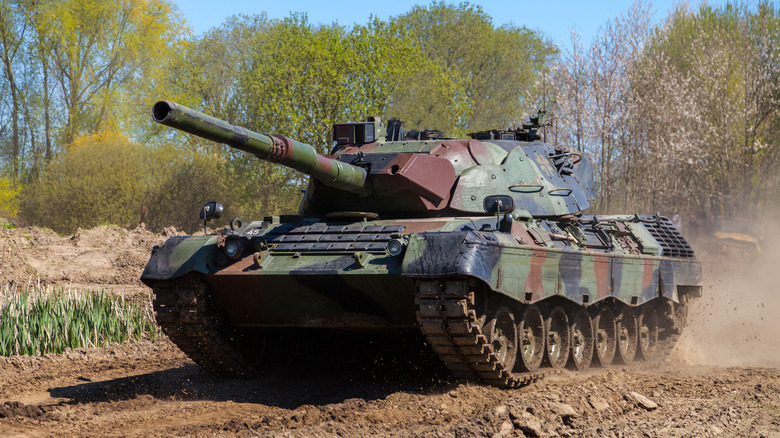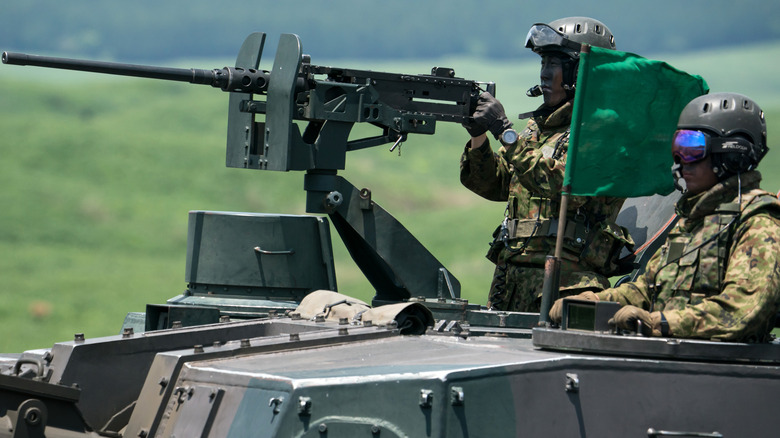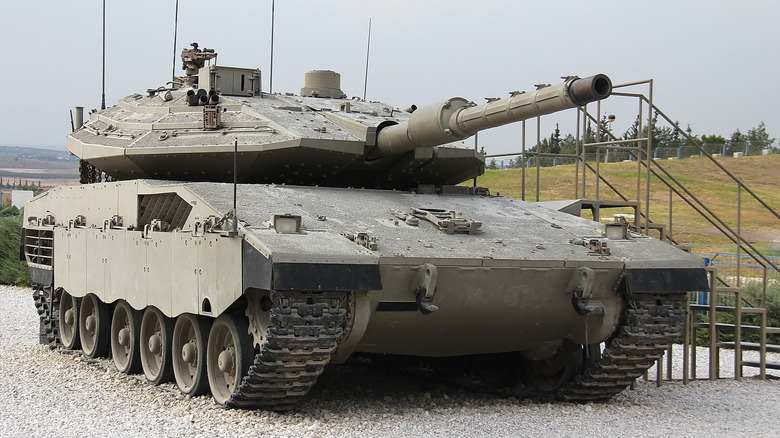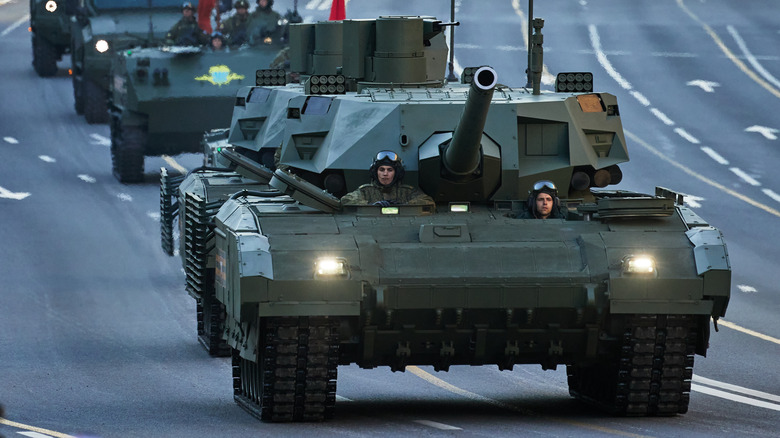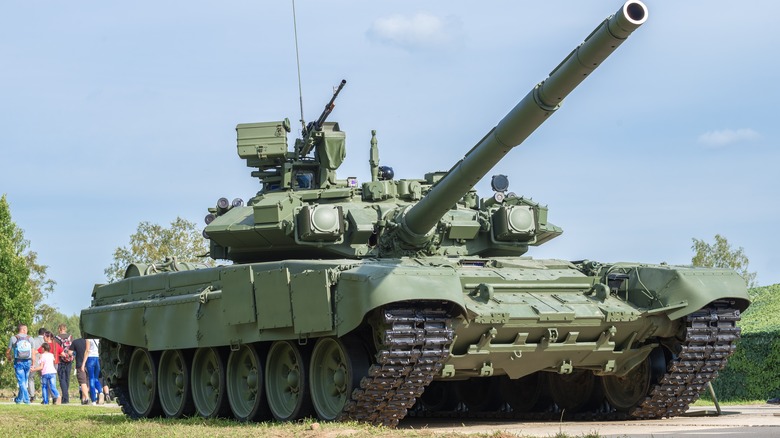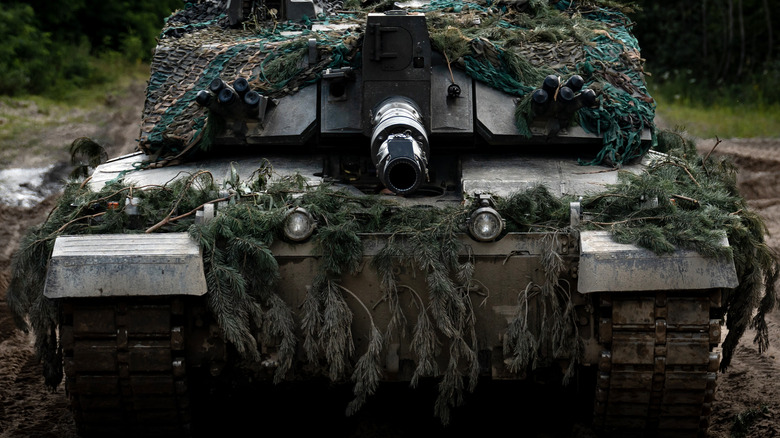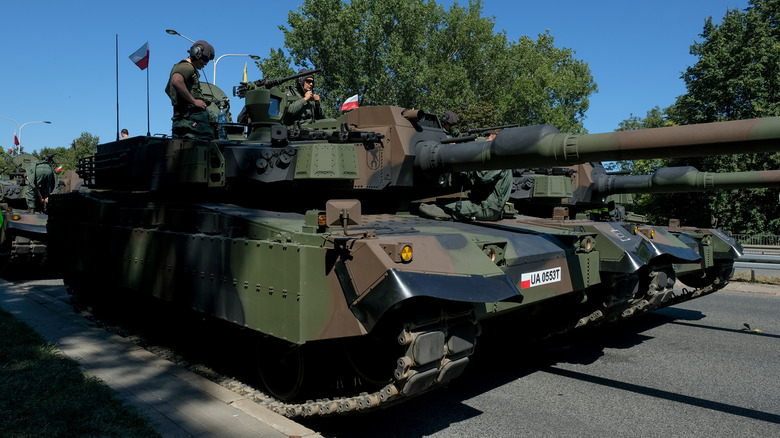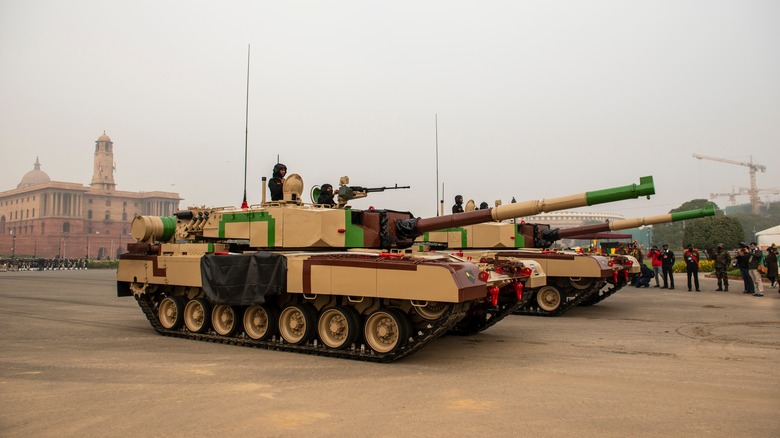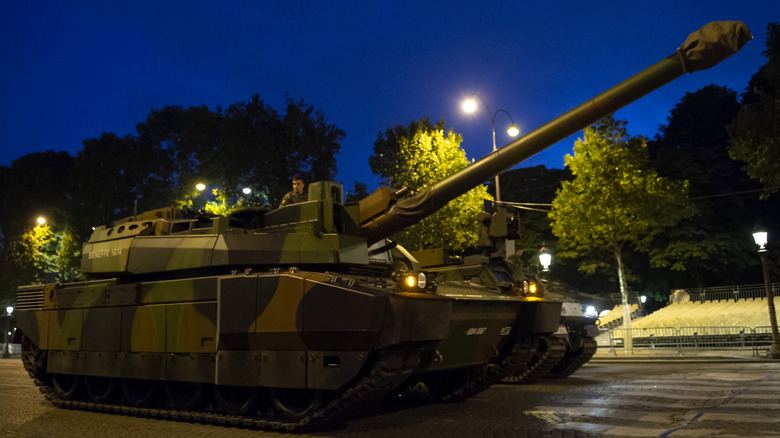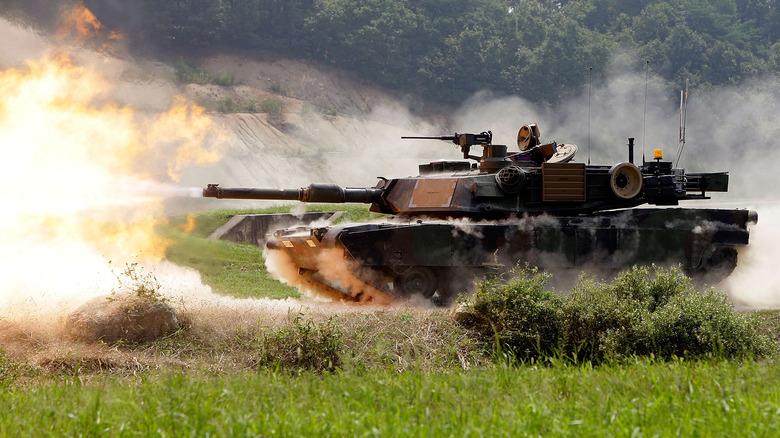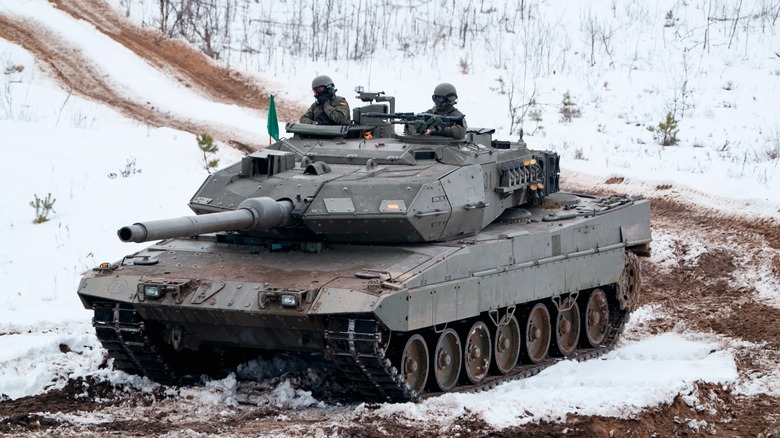10 Of The Most Expensive Military Tanks Ever Built
While modern warfare has changed dramatically since the days that tanks were first introduced in the early 1900s, the armored vehicle still plays a hugely important role in combat. Whether as a defensive deterrent or a sophisticated piece of attacking hardware, the main battle tank is a force to be reckoned with and can perform a vast array of functions on the battlefield. Even with today's advancement in drone technology and artificial intelligence, more than 100 years of development and refinement have created hugely impressive tanks.
The main battle tanks that most people are familiar with are a fine balance between firepower, mobility, and defensive prowess that use some of the most high-tech parts on the planet. They can take decades to research and develop, costing manufacturers billions to bring them to market. That's because they often utilize rare, composite materials that provide the best protection against attack and help keep them from being too heavy to move around effectively.
The result of all of that is that today's tanks are some of the most expensive pieces of equipment that any military purchases for its armies. Out of all the currently available tanks, these are the most costly.
Type 99 - $2.5 million
The Type 99 tank, also known by its designation ZTZ-99, is a Chinese main battle tank that first entered service in 2001. Intended to replace the older Type 88 tanks, it is a third-generation vehicle that now makes up the vast majority of China's tank forces alongside the Type 96 tank, with over 1,200 units manufactured since production started in 1998. Whether China needs such a large land force, considering that much of its military and expansion efforts are focused on maritime and air superiority, is unclear, but the Type 99 is certainly an impressive tank that is capable of competing with its Russian and American rivals.
Originally based on the older T-72 tank, the current Type 99 has been heavily upgraded and updated in recent years to help make it an effective and vital part of the People's Liberation Army. The weaponry of the Type 99 tank is now similar to both the Russian T-90 and the U.S.-made M1 Abrams. It also comes equipped with an advanced array of sensors and electronic systems that can help it track enemy tanks, providing accurate data for targeting. In terms of protection, it features composite armor and explosive reactive armor, which aims to damage incoming projectiles as they hit the tank to prevent them from causing major damage.
With a reported cost per unit of $2.5 million, the Type 99 is the most expensive tank in China's military. It is significantly more expensive than the Type 96, which may explain why the country has produced more than double the number of Type 96 tanks, as it is far more cost-effective, even if not quite as advanced as the Type 99.
Merkava - $3.5 million
The Merkava refers to a whole series of main battle tanks that are used by the Israel Defense Force as part of its Armored Corps. The first of these tanks entered service in 1979, and various upgrades and revisions have been released over the years, with the latest Merkava IV Barak variant first being delivered to the IDF in 2023. It is expected that up to 400 of this model may eventually enter service, replacing the current fleet of Merkava IV tanks.
What makes the Merkava IV Barak stand out is its focus on defense. The Trophy active protection system can shoot down drones, missiles, and other projectiles without any input from the crew, as the system can automatically track and fire at any potential threats. It also comes equipped with composite and modular armor that is tough enough to withstand plenty of punishment and a 120-millimeter smoothbore gun that allows it to hit back with incredible force.
External countries that want to purchase the latest model of the tank, the Merkava IV, are expected to pay in the region of $10 million per unit — a figure that is much higher than the price that Israel produces the tanks for. In 2003, the Israel Defense Force was paying just $3.5 million for each Merkava IV that was delivered to the military, while the most recent Merkava IV Barak costs around the same amount.
T-14 Armata - $3.75 million
The T-14 Armata is a Russian main battle tank that weighs 55 tons and comes equipped with a 152-millimeter main gun that fires Vacuum-1 rounds, an Armor-Piercing Fin-Stabilized Discarding Sabot (APFSDS) shell that can penetrate even the strongest armor at ranges of over a mile. The tank also features both a Kord 12.7mm machine gun and a PKTM 7.62mm machine gun, which can be used to combat close-range targets. Largely based on the modular Armata Universal Combat Platform, the T-14 began development in 2014 and several prototypes were created in the run-up to full production beginning in 2021.
The A-85-3A turbocharged diesel engine means the tank can reach a top speed of over 50 miles per hour and has a range greater than 300 miles, making it a maneuverable and agile tank despite its large size and weight. Additionally, the heavy armor made of steel and composite materials offers good protection against incoming fire, while the low silhouette of the vehicle helps ensure it is harder to spot and hit.
Despite a protracted development period and financial issues, the T-14 is a relatively cheap tank compared to many others currently in production. The basic version is expected to cost just $3.75 million per tank, although other variants could reach prices of up to $5 million.
T-90 - $4.5 million
Designed to replace the aging T-72 tank that first entered active service in 1969, the T-90 is a Russian-made main battle tank. Uralvagonzavod developed and manufactured the tank, which began being delivered to Russia's military in 1992. It is one of the few third-generation tanks that has been deployed to combat zones, with Russia using the tanks in Syria, Azerbaijan, and Ukraine. The T-90 has a 125 mm 2A46 smoothbore main gun that is amplified by the use of the 1A45T fire-control system.
The T-90 has proven popular outside of Russia, with nations such as India, Iraq, Syria, and Algeria all purchasing the tanks. In fact, thousands of armored vehicles have been exported even though it has proven to be vulnerable to several different forms of attack, including close-range RPG fire. It does have strong defensive capabilities, at least on paper, with composite and steel armor as well as an explosive reactive armor system.
One of the things that makes the T-90 so attractive is its price. Older models and those that are more basic without modern technological advancements can cost anywhere between $2.5 million and $3.5 million. However, the more recent T-90M models, which come with a new turret and extra powerful engine, have a price tag of $4.5 million.
Challenger II - $5 million
The Challenger 2 is the U.K. equivalent of the third-generation main battle tanks of other nations, such as the M1 Abrams and Leopard 2. An evolution of the Challenger 1, it entered service in 1994 and features a range of advancements and upgrades compared to its predecessor. This includes a 120-millimeter L30 rifled gun, a 37-mile-per-hour top speed, and a maximum range of 340 miles. Combined with its unique Dorchester 2 armor and two 7.62-millimeter chain guns, the tank sacrifices speed and agility in exchange for lethality and protection.
Production began in 1990 and the tank was first used by the British Army in 1998, continuing to this day until the vehicles are upgraded to the Challenger 3 model as part of a wide retrofit and upgrade to the army's tanks. Over 400 of the Challenger 2s have entered service, with Oman also using the Challenger II as its main battle tank. Before several Challenger 2 tanks were sent to Ukraine in 2023, the tank had a reputation for being invincible as none had ever been lost to enemy fire.
The exact costs for the Challenger 2 have never been officially confirmed by the British government. However, reports suggest that it came at a cost of between £4 million and £4.2 million, roughly equivalent to around $5 million.
K2 Black Panther - $8.5 million
The K2 Black Panther may not be as instantly recognizable as some of the other tanks you may have seen, but that doesn't mean it isn't effective and lethal. It is a South Korean main battle tank that entered service in 2014 following more than a decade of design and development. The vehicle was designed for high-speed scenarios and to make use of network-centric operations to collect and share information across military forces. This includes a KSTAM-II system that can auto-target enemies and an advanced fire control system from French company Leclerc that can acquire enemy units from up to six miles away.
Combined with its autoloading 120-millimeter L/55 smoothbore gun and a Tognum MT 833 diesel engine, the K2 Black Panther is a powerful and maneuverable tank. Equally capable in urban or open environments thanks to its hydropneumatic suspension and a top speed of 42 miles per hour, the tank performs similarly to the M1 Abrams in most scenarios. Its success has led to it being exported to Poland and the K2 Black Panther is also the basis for Turkey's Altay main battle tank. Other nations, such as Egypt and Romania, have both signaled intentions to import the tank.
The K2 Black Panther is officially one of the most expensive tanks on the planet, costing $8.5 million per unit to produce. That figure doesn't include early development costs and is strictly the price it costs the South Korean government to procure the tanks from the manufacturer.
Arjun Mk-1A - $9 million
The Arjun Mk-1A is an updated version of the original Arjun third-generation main battle tank that was first delivered to the Indian Army in 2004. Widely seen as one of the worst tanks ever built, the original model had several issues that made it less than desirable. This included a huge weight that made it unsuitable for many of India's roads and bridges, thus limiting its ability to move around the country. The fact that it was built with largely foreign components, meant mechanics and engineers in India were not able to properly maintain the tanks.
However, that hasn't stopped India from purchasing an additional 118 upgraded tanks in the form of the new Arjun Mk-1A. Equipped with dozens of improvements and quality-of-life upgrades, this version of the tank fixes many of the issues of its predecessor. However, the order has still been criticized and is largely viewed as a way of boosting India's defense sector rather than being an indicator of the quality of the Arjun Mk-1A.
India's order for the Arjun Mk-1A main battle tank is for 118 units and is worth a total of Rs 7,523 crore. Converting that to U.S. dollars and then dividing it among the number of tanks set to be delivered gives a cost price of around $9 million.
AMX-56 Leclerc - $9.3 million
Often simply known as the Leclerc main battle tank, the AMX-56 Leclerc is the backbone of the French Army's armored divisions and was designed to replace the AMX-30. An older tank — one that was originally designed during the 1980s and entered service in 1992 — the AMX-56 Leclerc will soon be replaced with the Leclerc XLR as France upgrades its current stock to the new standard. Along with France, both the United Arab Emirates and Jordan use the AMX-56 Leclerc, bringing the total number of units built since it was introduced to over 800.
The French tank features a 120-millimeter version F1 smoothbore gun that is compatible with standard NATO ammunition and an autoloader, which means it can fire up to nine times per minute. Manufactured by Nexter Systems, an emphasis was placed on high mobility and active protection to avoid or disrupt incoming fire rather than withstanding huge amounts of damage. A crew of just three is needed to operate the AMX-56 Leclerc, less than is usually needed for third-generation tanks.
While costs for the upgraded Leclerc XLR variant are not available, the original model was one of the most expensive tanks ever produced when it first went into production. In today's money, it was the equivalent of around $9.3 million.
M1A2 SEP Abrams - $19 million
For more than 40 years, the M1 Abrams has been an ever-present sight on battlefields that involve the U.S. military. The first main battle tank of this type joined the U.S. Army in the 1980s and was named in honor of General Creighton W. Abrams. The M1 Abrams has been continually updated with new features and improved systems over the years and now features Chobham armor, a 120-millimeter smoothbore cannon, and a 1,500-horsepower engine capable of reaching a top speed of 42 miles per hour.
The M1A2 SEP Abrams is an upgraded variant of the baseline M1A2 that first began production in 1992. This 2015 model features updated anti-tank protection, a new thermal sight, graphite coating for the armor, and a digital battlefield management system that automatically tracks friendly forces on digital maps. It is essentially the most advanced version of the M1 Abrams that is available for export and comes equipped with the Trophy Active Protection systems to protect against incoming projectiles.
All of that technology, on top of a tried and tested base, doesn't come cheap, though. An agreement reached with Poland saw the European country pay $4.75 billion to acquire 250 M1A2 SEP Abrams tanks. Meanwhile, Romania spent $1.07 billion for 54 tanks, suggesting the unit cost for the tanks is around $19 million.
Leopard 2A8 - $30 million
Alongside the M1 Abrams, the Leopard 2 tank is arguably the most successful and widely used in the world. The third-generation tank was originally developed in the 1970s for exclusive use by West Germany's armed forces and, since its introduction into service in 1979, has seen at least 3,600 units built. Facing superior numbers from East Germany and its Soviet Allies, West Germany aimed to produce a technologically advanced model that would outperform opposing tanks on the battlefield – something that it certainly managed to do.
A 1,500-horsepower engine allows the tank to operate on all terrain and reach a top speed of 42 miles per hour. In terms of firepower, the tank boasts a 120-millimeter main cannon that can be fired on the move thanks to a stabilization system and two 7.62-millimeter machine guns. Throw in a variety of fire systems and targeting computers as well as new armor protection, and the Leopard 2 is a deadly, accurate, and maneuverable main battle tank. It is little wonder that it has been exported to dozens of other nations across NATO and further abroad. These include a wide array of European countries as well as Chile, Singapore, and Qatar.
Recent orders suggest that the cost of the most modern version of the tank, the Leopard 2A8, is incredibly high. In 2023, Germany pledged to buy 18 new tanks to replace those it had donated to Ukraine for $578 million or roughly $30 million each. Meanwhile, the Netherlands is buying 14 less advanced Leopard A4 tanks for around $12 million each.
